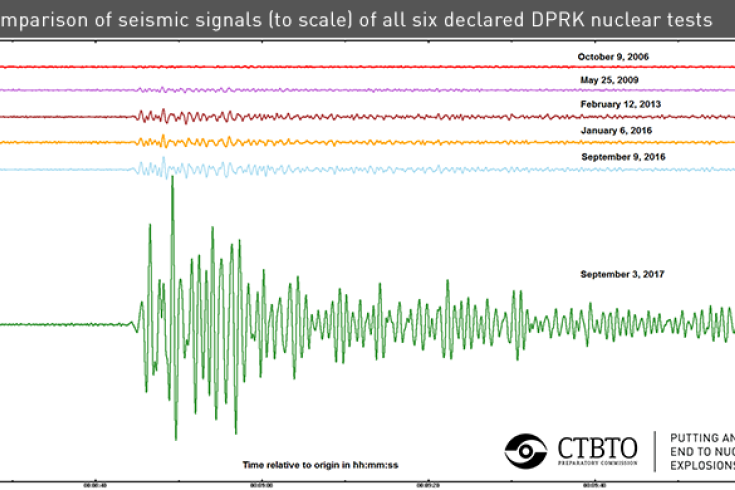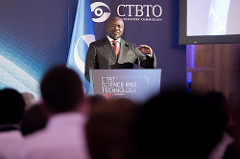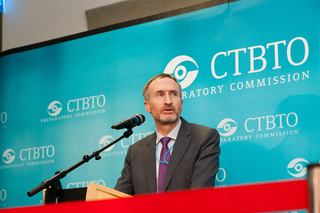Meteorological support for nuclear disarmament and weapons control
This web page continues my previous one at BOKU.
Staff: Petra Seibert
Former staff: Anne Tipka (now at CTBTO), Radek Hofman (now at IAEA). At BOKU: Andreas Frank (now at ZAMG), Paul Skomorowski (now at ZAMG)
>> Jump to Disarmament and related envents
>> Jump to DPRK 2016 information
>> Jump to DPRK 2017 information
Separate pages:
2017 Nobel Peace Prize for ICAN and information on the TPNW
Treaty on the Prohibition of Nuclear Weapons (TPNW)
TPNW Scientific Advisory Group (TPNW)
ATM Challenges - Statistical evaluation
Activities:
Ongoing:
- Participation in the Working Group B of the Comprehensive Nuclear Test-Ban-Treaty Organisation / Preparatory Commission
- Research to support source location from radionuclide measurements
- WOSMIP
Past activities:
- Participation in source location experiments of CTBT/PrepCom International Data Centre and WMO
- Organisation of the Kick-off workshop of the new Independent Group of Scientific Experts on the detection of clandestine nuclear-weapons-usable materials production (iGSE)
Recent conferences:
-
Participation in the CTBTO Science and Technology Conference 2019, 24-28 June 2019 at the Hofburg Palace in Vienna. Contributions:
- Filling a gap in the wet scavenging scheme in FLEXPART 10.3 , Petra Seibert, Anne Philip (poster)
- Atmospheric Dispersion and Ground Level Deposition of Cs-137 Released From Chernobyl Nuclear Power Plant Accident Efem Bilgic, P. Seibert, A. Philipp (poster)
- ECMWF data sets as input for the ATM FLEXPART prepared by a new version of the flex_extract tool A. Philipp, L. Haimberger, P. Seibert (poster)
- Filling a gap in the wet scavenging scheme in FLEXPART 10.3 , Petra Seibert, Anne Philip (poster)
-
Participation in the CTBTO Science and Technology Conference 2017, 26-30 June 2017 at the Hofburg Palace in Vienna. Contributions:
- Uncertainty Measurement in Atmospheric Transport Modelling and Atmospheric Dynamics, Petra Seibert (Panel discussion)
- Quality Assessment of Meteorological Data from CTBTO/IMS Radionuclide Stations, P. Seibert, C. Jank, A. Philipp (poster)
- Influence of Resolution on the Performance of FLEXPART with ECMWF Data in the ATM Challenge 2016 P. Seibert, A. Philipp (poster)
- A Framework for Systematic Testing of an Improved Wet Deposition Scheme for the Lagrangian Dispersion Model FLEXPART Oral, A. Philipp, P. Seibert
- Inverse Modelling Analysis of Xe-131m Measurements over East Asia in April 2013, Poster, R. Hofman, P. Seibert
- Inverse Modelling Analysis of the Radioxenon Detections in Takasaki, April 2013 as a Step Towards Data FusionPoster, P. Seibert, R. Hofman, A. Philipp
 Participation in the 5th Workshop on Signatures of Medical and Industrial Isotope Production (WOSMIP V), Egmont Palace in Brussels, Belgium May 12-14, 2015.
Participation in the 5th Workshop on Signatures of Medical and Industrial Isotope Production (WOSMIP V), Egmont Palace in Brussels, Belgium May 12-14, 2015.More: WOSMIP web site, Workshop summary reports
- Poster: Assessment of Network Sensitivity under the Presence of Civil Radioxenon Sources from an Atmospheric Transport Modelling Perspective
 ICAN Civil Society Forum, Vienna, 6/7 Dec 2014, organised by ICAN Civil Society Forum, Vienna, 6/7 Dec 2014, organised by  |
and the |  Vienna Conference on the Humanitarian Impact of Nuclear Weapons, 8/9 Dec 2014. |
Majority of countries pledge to support negotiations towards a nuclear weapon ban treaty
UN General Assembly First Committee Vote on the Humanitarian pledge (map)
Information about nuclear events
(reverse chronological order)April 2018: Discussion on DPRK nuclear-test moratorium
Recently, a number of media report that North Korea's move may be caused by the DPRK test site being unusable anyway, referring to the strong aftershocks of the September 2017 test (see also information below.), see for example New York Post or The Guardian. These articles are based on a report by a Hongkong-based Chinese newspaper, saying that an article will soon come out on the testsite destruction in GRL, by a team around Lianxing Wen. Rumours are spread that even respuspended radioactive dust from the mountain's interior could threaten Chinese territory. While we don't have solid information, this at least appears to be far-fetched.
As explained on the 38North web site, even if the tunnel system used collapsed, the Punggye-ri test site has more sections, which are probably not affected. See also a follow-up article on 38N.
DPRK nuclear test of 03 September 2017

|
CTBTO/PTS Comparison of seismic signals (to scale) of all six declared DPRK nuclear tests, as observed at IMS station AS-59 Aktyubinsk, Kazakhstan. |
- First analysis by 38North, 3 Sept 2017
- Analysis of satellite imagery by 38North, 5 Sept 2017
- Analysis by 38North, 12 Sept 2017.
Some highlights: 250 kt yield - close to what 38 North had previously determined to be the maximum estimated containable yield for the Punggye-ri test site. - significant “cracking” (possibly extending to the surface) ... Such cracking facilitates radioactive gas seepage in other environments. It remains to be seen, however, whether or not the North Portal will ever be used for another nuclear test. There are still two unused additional tunnel complexes (served by the South and West Portals) that are also deemed potentially capable of further nuclear testing, albeit for tests having lower yields than that of the sixth test.
- Signal comes from known DPRK test site, close to previous tests
- Signal strength was about 5-10 times higher than Sept. 2016 test (which was estimated at 10-30 kt). The details of CTBTO's interactive analysis have not yet been published but there is a (re)tweet on CTBTO_alerts that says the mb is 6.07 and calculates an estimated yield of 140 kt.
- The second seismic signal 8 min after the main one is interesting. It can indicate a cavity collapse or a mass movement on the mountain surface. Analysis of satellite imagery posted on the 38North web site reports small landslides but no collapses of cavities that deform the surface.
- If there was a prompt release of radionuclides into the atmosphere, they will be sampled by the CTBTO station RN58 Ussurysk probably on Monday 4 Sept 2017, with the analysis being available ca 48 h later. Note that the Xe measurement at this station is not yet certified.
- Given the strength, it is reasonable to assume that the device indeed had a fusion component; however, boosted fission is more likely than a two-stage thermonuclear device.
- The progress on weaponisation is still difficult to judge (i.e., whether the device would fit on the available missiles, and whether it would survive the re-entry phase of an ICBM).
- The strength of the detonation means that more radionuclides were produced and that it will be more difficult to contain them, therefore the chance to see a signal in the CTBTO radionuclide network is higher this time. In addition, national verification means in form of airborne radionuclide sampling (and probably additional surface sampling) are also undertaken by some countries.
- North Korea's Nuclear Year In Review - And What's Next (Nuclear Threat Initiative)
- How earthquake scientists eavesdrop on North Korea's nuclear blasts
Nuclear Weapon Issues in the 21st Century, a two-day seminar with PDFs of presentations(disappeared), at Elliott School of International Affairs , George-Washington-University, Wash. DC, USA
This time, the DPRK test deserves a different attitude - not only because of its magnitude, but also because of DPRK's progress in missile technology and last not least because of the personalities of political leaders involved. Even if the general public's attention has decreased, the risk of war has not!
DPRK nuclear test of 09 September 2016
DPRK nuclear test of 06 January 2016
Currently available information shows that the magnitude of this test is very similar to the 2013 test (ca. 10 kt). Thus, claim of the DPRK to have tested a hydrogen bomb (fusion as the primary source of energy, typically over 1 Mt yield, rarely under 100 kt) appears to be wrong. At most, they may have tried to test a boosted fission device; it would be hard to say whether there was a significant boost effect or not.
If a prompt release of radioxenon would have occurred, it would have been measured at the Takasaki monitoring station in Japan a few days later, which did not happen. A delayed release through the access tunnel is still possible. Analyses (see below) indicate that the rock overhead of the 2016 test site was larger than 2013; a prompt release thus is quite unlikely.
- 14 Dec 2015: Did Somebody Say H-bomb?
- 02 Dec 2015: New Nuclear Test Tunnel Under Construction at North Korea's Punggye-ri Nuclear Test Site
- 09 Jan 2016: North Korean Nuclear Test: Imagery Shows No Indicators
- 01 Feb 2016: The Challenge of Predicting Future North Korean Nuclear Tests (has very nice Google Earth visualisation of various location estimates for all DPRK tests)
Read Ich sehe nicht, wieso Nordkorea seine Atomwaffen jemals aufgeben sollte instead.
DPRK nuclear test of 12 February 2013
May 2010 radionuclide detections over East Asia
DPRK nuclear test of 25 May 2009
Contemplating a third nuclear test in North Korea by Frank V. Pabian and Siegfried S. Hecker, Bulletin of the Atomic Scientists, 08/06/2012 - 13:55 (online). Has discussion of 2006 and 2009 tests and their location.
Detailed news with technical information on the CTBT public website
DPRK nuclear test of 09 October 2006
Publications:
Petra Seibert and Paul Skomoroswki (2009), Source Location for the CTBTO-WMO Exercise 2008, Oral presentation at EGU General Assembly 2009. (pdf, 3.5 MB)
A. Becker, G. Wotawa, L.E. de Geer, P. Seibert, R.R. Draxler, C. Sloan, R. D' Amour, M. Hort, H. Glaab, P.Heinrich, Y. Grillon, V. Shershakov, K. Katayama, Y. Zhang, P. Stewart, M. Hirtl, M. Jean, P. Chen (2007): Global backtracking of anthropogenic radionuclides by means of a receptor oriented ensemble dispersion modelling system in support of nuclear-test-ban treaty verification. Atmos. Environ., 41 (21), 4520-4534 ([Abstract; fulltext for Elsevier subscribers] )
Wotawa, G., Lars-Erik DeGeer, Philippe Denier, Martin Kalinowski, Harri Toivonen, Real D'Amours, Franco Desiato, Jean-Pierre Issartel, Matthias Langer Petra Seibert, Andreas Frank, Craig Sloan and Hiromi Yamazawa (2003): Atmospheric transport modelling in support of CTBT verification -- Overview and basic concepts. Atmos. Environ., 37 (18), 2529-2537 [Abstract; fulltext for Elsevier subscribers].
Links to institutions
- Comprehensive Nuclear Test-Ban-Treaty Organisation / Preparatory Commission (CTBTO)
- Delegation of the European Union to the International Organisations in Vienna
- United Nations Office for Disarmament Affairs (has a rich set of resources)
- Carl Friedrich von Weizsäcker Centre for Science and Peace Research at University of Hamburg
- International Network of Engineers and Scientists Against Proliferation (INESAP)
- Independent Group of Scientific Experts on the detection of clandestine nuclear-weapons-usable materials production (iGSE)
- Central Institute of Meteorology and Geodynamics, Vienna (National Data Centre for CTBT)
- Ministry of Foreign Affairs, Vienna, Abt. II.10 (National Authority for CTBT)
- Meteorological Service of Canada, Environmental Emergency Response Division, Montreal
- Vienna Center for Disarmament and Non‑ProliferationInternational (VCDNP)
- International Committee for Robot Arms Control (ICRAC), has a newsletter and list of supporters
Links to resources
- The Nuclear Weapon Archive includes technical background on North Korea's first nuclear test
- Arms Control Association
- Nuclear Threat Initiative resources on DPRK
- 38north.org (John Hopkins Univ.) analyses on DPRK weapons of mass destruction activities
- IAEA focus on DPRK
- International Panel on Fissile Materials
- Future of Life Institute (has sections on artificial intelligence, biotechnology, nuclear weapons, and climate change)
- CTBTO photo stream - 40 photos of radionuclidate stations worldwide (but not all 40)
- Austrian Foreign Ministry (BMEIA) web page on Nuclear-weapon-free zones which contains a link to the study A Nuclear Weapon-Free Zone in Europe (PDF) commissioned by Austria and Switzerland.
- sicherheitspolitik-blog.de (not active)
- Restricted Data: The Nuclear Secrecy Blog by Alex Wellerstein, historian of science who specializes in the history of nuclear weapons and nuclear secrecy
- Bulletin of the Atomic Scientists (has also a nice visualisation of NPPs in the world as a function of time)
- Johnston's Archive Nuclear Weapons (has also list of radiological incidents)
Links to disarmament and related events
-
Workshop on Signatures of Man-Made Isotope Production (WOSMIP),
has now webinar series on Wednesdays (archived)
Nuclear Ban Treaty: United Nations Conference to Negotiate a Legally Binding Instrument to Prohibit Nuclear Weapons, Leading Towards their Total Elimination (TPNW)
Official conference website
ICAN (International Campaign to Abolish Nuclear Weapons)
my page on Nobel prize for ICAN and on the TPNW
Background paper: A treaty banning nuclear weapons: diversion or breakthrough?
 May 2017, Vienna: Preparatory Commission for the Nonproliferation Treaty (NPT) Review Conference 2020
May 2017, Vienna: Preparatory Commission for the Nonproliferation Treaty (NPT) Review Conference 2020
For 2022/2023 NPT and TPNW Conferences, see here
URL: https://homepage.univie.ac.at/petra.seibert/nucdisarm.html


